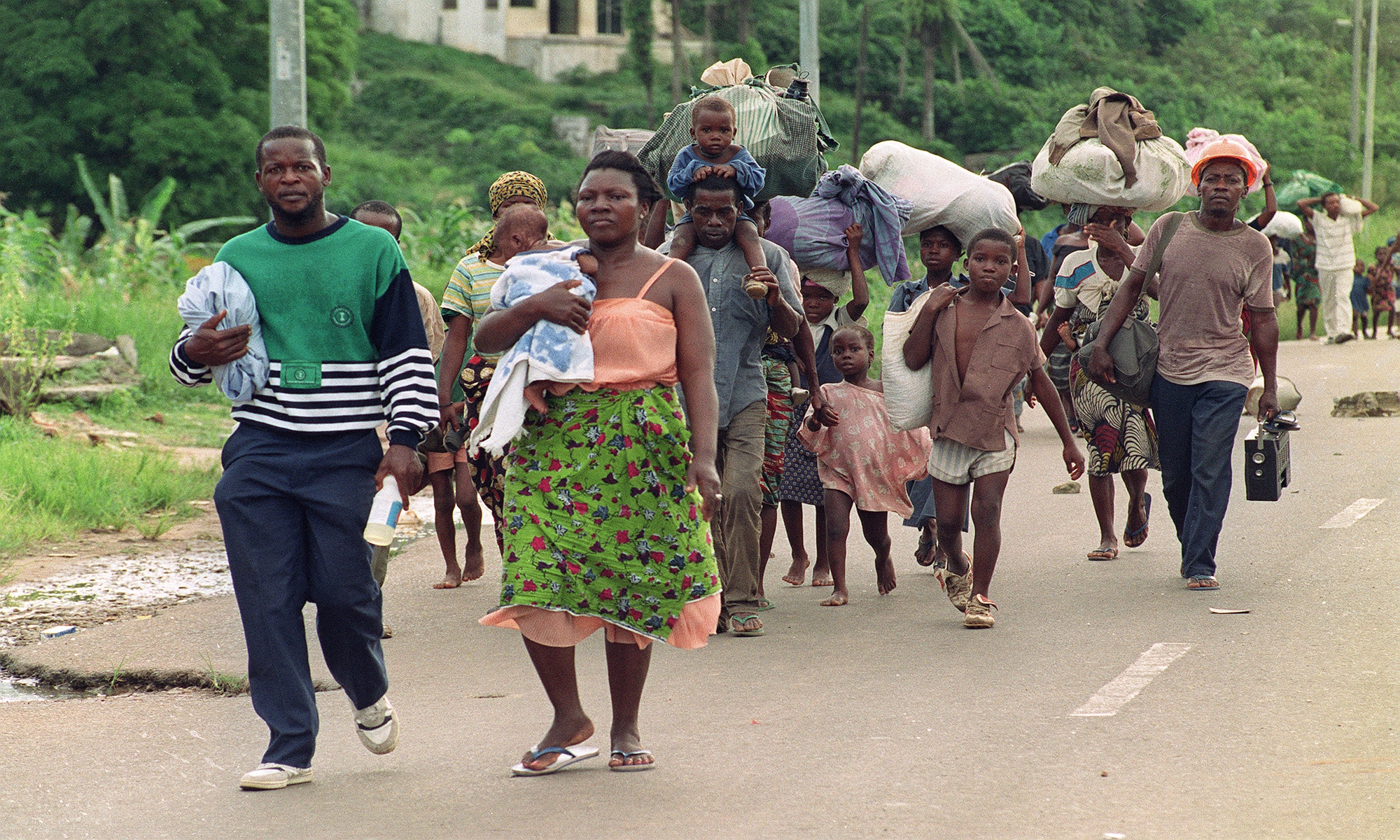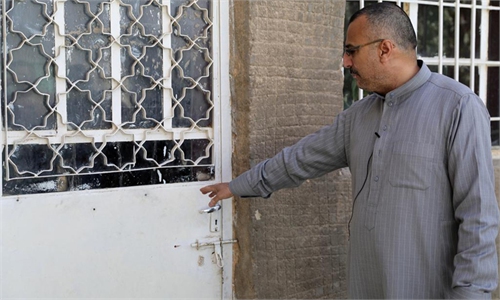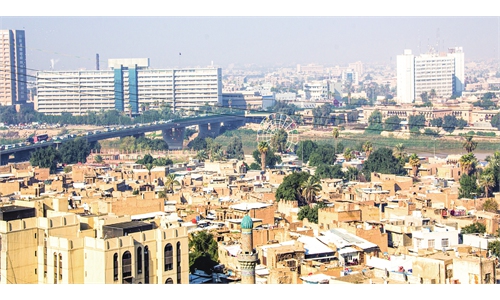IN-DEPTH / IN-DEPTH
US invasion of Panama shames ‘just cause’; ‘Operation Sharp Edge’ left Liberia continually ‘bleeding’
Shattered justice

Refugees flee Paynesville on August 10, 1990 during heavy fighting between the rebels of the National Patriotic Front of Liberia (NPFL) and the Armed Forces of Liberia (AFL) loyal to president Doe. Photo: AFP
From late 1989 to early 1990, the US invaded Panama under the guise of human rights and drug control, and fought a blitzkrieg codenamed "Operation Just Cause." It took only 15 hours for the US military to defeat the Panamanian army and overthrow the Panamanian government. It took another 15 days to capture Manuel Noriega, the former head of the Panamanian government, and extradite him back to the US for trial.
Although the US military then withdrew from Panama, the invasion still besmirches the word "justice." The war left Panama with tens of thousands of refugees and a dilapidated city. Moreover, the US military controlled news sources and manipulated public opinion by whitewashing the war of aggression. The deception of the Panamanian people is yet to be redressed years on.
Powell's tactics
In the early morning of December 20, 1989, the US sent nearly 30,000 soldiers to invade Panama. Aside from attacking military facilities, the US military also bombed several residential areas in Panama City, causing heavy casualties among civilians. After the Panama Defense Forces gave up resistance, the US military increased its troop count to brutally suppress the spontaneous militia resistance organizations in Panama.
The US troops withdrew from Panama in March 1990 but the war left Panama in absolute disarray. Some locals described the community after the bombing as "Hiroshima after the atomic bombing." Due to the US military's manipulation of news and public opinion, the number of civilian casualties in Panama was not accurately reported, and reports to come later only mentioned that thousands of Panamanians died in this war.
In 2017, a US magazine report mentioned how the US military concealed the truth during the Panamanian. The US military planned to invade Panama and it deceives the world by calling the invasion "a just cause." According to media reports, the name "Just Cause" was proposed by Colin Powell, then chairman of the Joint Chiefs of Staff of the US military.
Moreover, the offensive strategy of the US military was also very deceptive. Its bombing only targeted Panamanian military camps and individual ghettos, so that in areas where the rich and middle-class lived in Panama, the war was hardly felt. Some media sources described that, to the wealthy people in Panama, it seemed as if they were watching a firework show. There were even residents in wealthy areas who welcomed the arrival of the US military, under the misguided belief that the US military had been deployed for the purposes of "human rights and justice." The media coverage controlled by the US military also distorted reporting on the war.
Assassination of reporters
The actions taken by the US military, in fact, had nothing to do with justice. On one hand, Panama's troubles were entirely the fault of the US. The US had been deeply involved in Panama affairs for many years and everyone knew that it was for the Panama Canal.
The Isthmus of Panama, the section which the canal is located, originally belonged to Colombia. In order to achieve the purpose of occupying the canal, the US instigated Panama to become independent from Colombia, delineated an exclusive area around the canal and set up military bases. The US military even established the headquarters of its southern army in Panama.
Noriega was originally supported by the US, but when he demanded that the canal be returned to Panama, the Americans decisively overthrew Noriega's ruling.
Unlike the Vietnam War, during which time the US allowed journalists to travel with the army, when the US military invaded Panama, it imposed strict news control. At that time, there were no newspapers published in Panama. Journalists from various countries couldn't act at will and had to strictly follow with news materials from news agencies of the US military. Therefore, the news about the Panama War at that time was intentionally released by the US military.
According to reports, a Spanish photojournalist named Rodriguez disregarded the ban by the US military to capture and publish photos of the real situation of the war. On December 21, 1989, outside the Marriott Hotel in Panama, as witnessed by the public, Rodriguez was shot and killed.
The Associated Press claimed that the US troops stationed at the hotel at that time and the US troops in the armored vehicles driving to the hotel from outside mistook each other for the Panamanian army and shot at each other. During the exchange of fire, three journalists, including Rodriguez, were shot outside the hotel.
In June 1990, according to a New York Times report, Rodriguez's family filed a lawsuit against the US military, demanding that the US military take responsibility for Rodriguez's death and make compensation. Spanish foreign ministry officials also urged the US military to find out the truth. A Spanish official said that the incident-related information provided by the US military was incomplete, implying that the US was deliberately concealing certain things.
Unsurprisingly, the lawsuit ultimately fell through, and no one in the US military was made responsible for Rodriguez's death. In another lawsuit that attracted worldwide attention, former Panamanian leader Noriega was found guilty by a US court and sentenced to imprisonment.
A 2013 report by the American media Consortium News stated that the US overthrew the Noriega regime under the guise of drug control but the result of the war showed it had no positive influence on preventing drug flow into the US from Central America.
Ironically, after the US ousted Noriega, Panama's economy and people's livelihoods were, at once, in trouble, which ironically stimulating the development of the drug trade. In addition, under the unremitting struggle of the Panamanian people, Panama finally took back the jurisdiction and operation authority of the Panama Canal on the last day of the 20th century. For nearly a hundred years before that, the Panamanian government and people could only get a fraction of the proceeds from the canal from the US.
The shadow of the invasion war has not been forgotten by the people of Panama. In 2014, Panama produced a documentary called Invasion, which recorded this invasion war launched by the US through the recollections of the people.
The deceptive tactics of the US may have concealed the truth for a while, but they could not cover it up forever. During the US invasion of Panama, a number of brave Panamanian military and civilians resisting the invasion were falsely labelled as being part of Noriega's private armed forces. More than 30 years on, Panama has finally vindicated these national heroes who resisted against the US invasion, and some of them have even been laid to rest in the martyrs' cemetery.
In April 2022, 33 years after the US invasion of Panama, Panama designated December 20 of each year as a national day of mourning to commemorate compatriots who died under US bombardment.
Some media analysts have since stated that the US invasion of Panama marked a watershed moment in history. From this war onward, the US military, without any concern of the aftermath of the Cold War, initiated a blitzkrieg model of suppressing the enemy with absolute force. Moreover, the act of arresting and trying the head of another country also set a historical precedent. It is reported that when Noriega was on trial in 1992, a US congressman warned that international relations must be established on a rational basis... if the US wants to earn the respect of other countries, this method will not work.

A woman puts a Panamanian national flag over the grave of relative killed in the 1989 US military invasion to Panama, during a ceremony commemorating the 30th anniversary of the invasion, at the Jardin de la Paz cemetery in Panama City, on December 20, 2019. Photo: AFP
'Operation Sharp Edge' left Liberia continually 'bleeding'
In 1990, the Western African country of Liberia was in the midst of civil unrest. On August 4 that year, the US announced Operation Sharp Edge, citing a threat to the safety of its nationals in Liberia due to the war. The US dispatched troops to invade the Liberian capital, Monrovia, from sea and air and began the evacuation of its citizens. The military operation lasted until January 9, 1991, evacuating nearly 3,000 foreign nationals, including Americans, from Liberia.
After the withdrawal of US troops, Liberia's civil war continued for another seven years before a new president was elected. Affected by years of internal conflict, Liberia was, for a long time, one of the world's poorest countries. Despite the country's rich mineral and rubber natural resources, the people had never benefited from national development.
According to the typical Western narrative, and also the pretext for US military intervention in the Liberian conflict, the instability and backwardness of Liberia were mainly attributed to the humanitarian disaster caused by the locals' savagery and greed. In response to this alleged attrition of societal norms, the US and the Western chose not to "stand by," hence the military intervention.
In his 2020 book Two Centuries of US Military Operations in Liberia: Challenges of Resistance and Compliance, Danish scholar Niels Hahn unraveled the lie propagated by the US. Hahn pointed out that the perennial civil war in Liberia resulted from both internal and external factors. Internally, disparities in wealth, social stratification, and religious and ethnic conflicts played significant roles. Externally, the US exploited instability within Liberia to incite further discord. Further analyses revealed that the internal causes of Liberia's unrest were also largely orchestrated by the US.
Liberia was established as a nation in 1847 when the US disregarded local opposition, forcefully purchasing land in West Africa to settle freed Black slaves. These individuals, carrying what can be considered "American genes," established Liberia under the guidance of the US, mirroring the US' model of governance.
However, these settlers were seen as new colonizers by the indigenous populations. The US, driven by its interests, has had a considerable hand in Liberia's development over the last century, often involving military interventions.
The US also used Liberia as a battlefield in its power struggle with other major countries in Africa, which led to political instability and a challenging fate for Liberia, with the people's lives mired in years of hardship.
Returning to the armed invasion of Liberia by the US, the then-president Samuel Doe had ascended to power through a US-backed coup that killed his predecessor. With US' support, Doe instigated a ferocious purge against the previous administration. However, when Doe tried to resist against the US' total control over Liberia, relations soured, and the US started supporting new anti-government forces against Doe's regime, leading to a full-scale civil war in March 1990. Doe, in his attempts to flee, was ultimately captured and brutally killed.
After the US withdrawal, a "warring states" scenario emerged, with various forces vying for the presidential "throne." In the Liberian capital, Monrovia, control frequently shifted hands, to the extent that government forces controlled the city by day, while rebels occupied it by night.
Hahn incisively pointed out that the US was actually the master director of internal conflicts in Liberia. The US' continuous search and cultivation of spokespeople for its own interests in Liberia were decisive factors in the country's instability.
After US forces withdrawal, political instability prevailed in Liberia. As suggested by the name of the US military operation, the "Sharp Edge" had left, yet Liberia continued "bleeding." From 1990 to 1997, Liberia went through four transitional government leaders until Charles Taylor was finally elected as president in 1997. However, the US viewed him as a radical nationalist and attempted to overthrow his rule. As American scholar Noam Chomsky stated, the US definition of radical does not refer to a country's policies per se, but rather to their disobedience to US' dominance.


